Since I got from the beach to the main street, I zigzagged a little until I reached a nautical club where I decided to sit down and drink something refreshing. This club did not face the Caribbean Sea, but rather the Nichupté Lagoon. It was not very windy there at all and I found a table in a deep shade which felt very good, although I had already applied some suntan lotion. This was basically one of the main reasons why I wanted to find a place to sit down and make a break, since I was not tired at all, but I was worried lest I got sunburned. While I was sitting there, everything seemed to be under control, i.e., I could not see any redness on my skin.
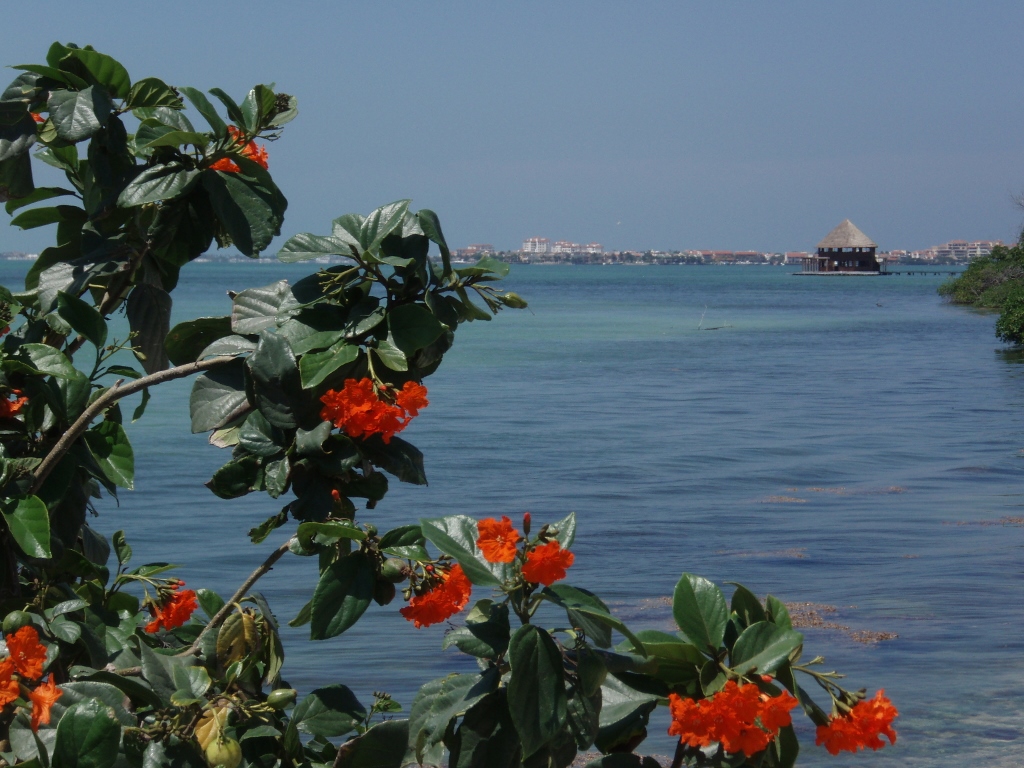 View at the Nichupté Lagoon
View at the Nichupté Lagoon
After that nice and relaxing break, I decided to go back to the beach and continue with my walk there, but as I was passing by some “wilder” sections of the island I noticed a “domestic” animal.
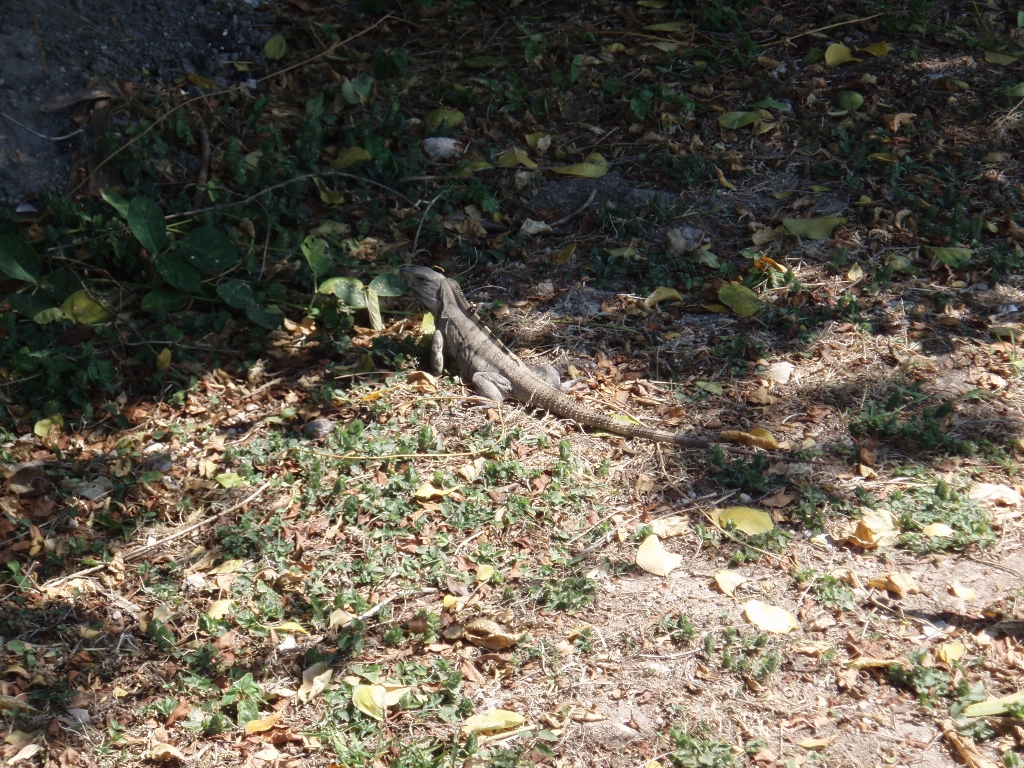 Iguana in Cancun’s hotel zone
Iguana in Cancun’s hotel zone
I have already mentioned that there is a certain problem in getting from the main street to the beach on account of the hotels and resorts the properties of which within the tourist zone are mostly adjacent one to the other and they do not permit passers-by to go through, but only their guests. This time I applied the same tactics as when I got here from the beach, i.e., I simply headed through the hotel not asking anybody anything, but I did this in a most casual way and full of confidence, as if I had really been a guest of the hotel, so nobody asked me anything and soon I reached the beach.
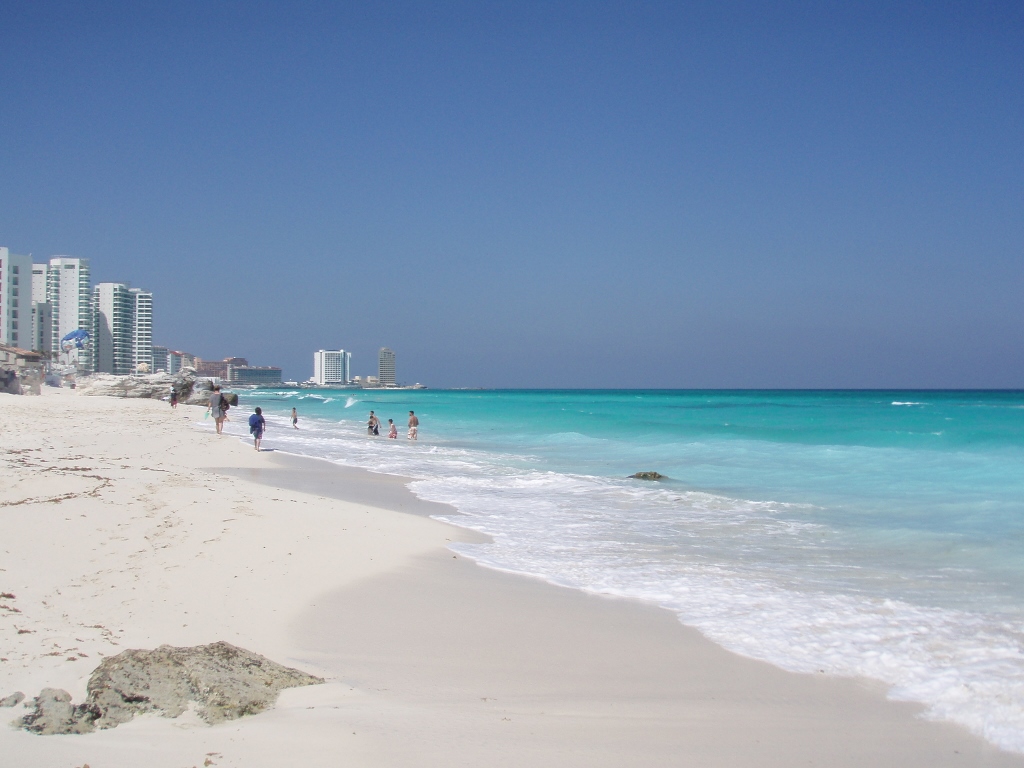 Beach in Cancun
Beach in Cancun
Since the Sun still seemed very strong, I tried from time to time to move from the beach to the shade for a short while and from there I could also observe some other details. For instance, some rocks on the beach in Cancun. Namely, there are not only some rocks that may be seen here and there on the bottom of the shallows, but also those that are like walls. This certainly did not spoil the beauty of the place in the least.
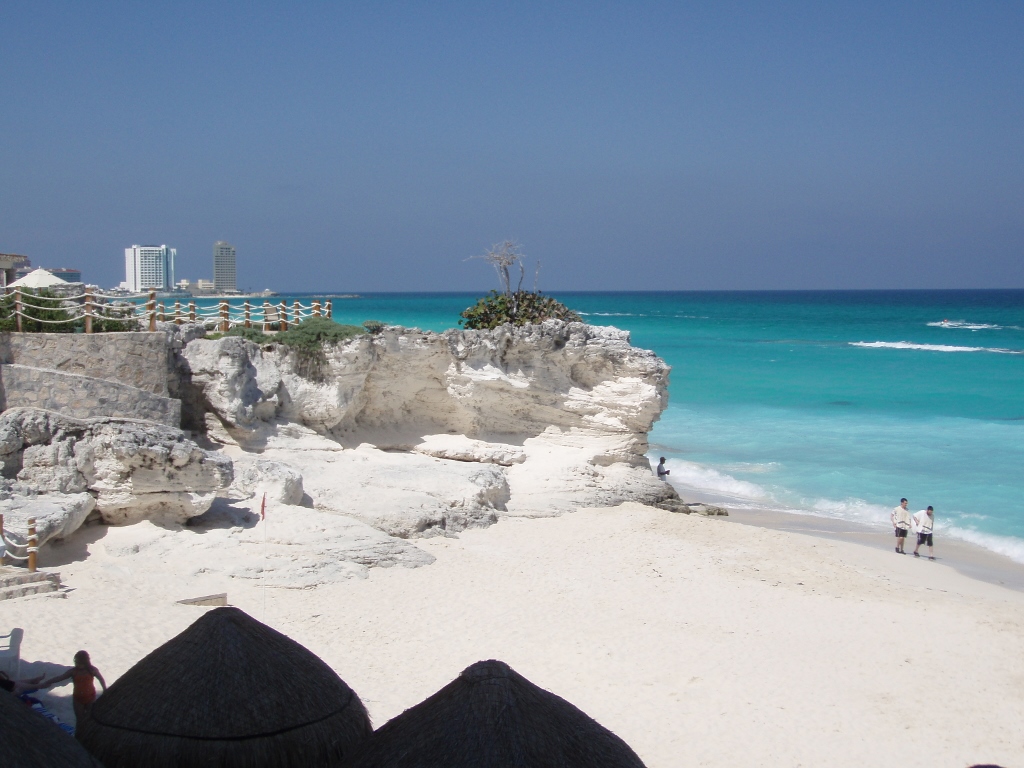 Beach in Cancun
Beach in Cancun
The colours were incredible, especially the whiteness of the sand and the turquoise colour of the water in the shallower sections of the Caribbean Sea.
In addition to the hotels and resorts, there are also apartment buildings by the beach which have flats that have already been sold to individual private owners and/or are rented out. Thus I came to some high-rise buildings with large balconies and I could easily imagine myself there sitting not for hours, but for days, watching the stunning waters of the Caribbean Sea.
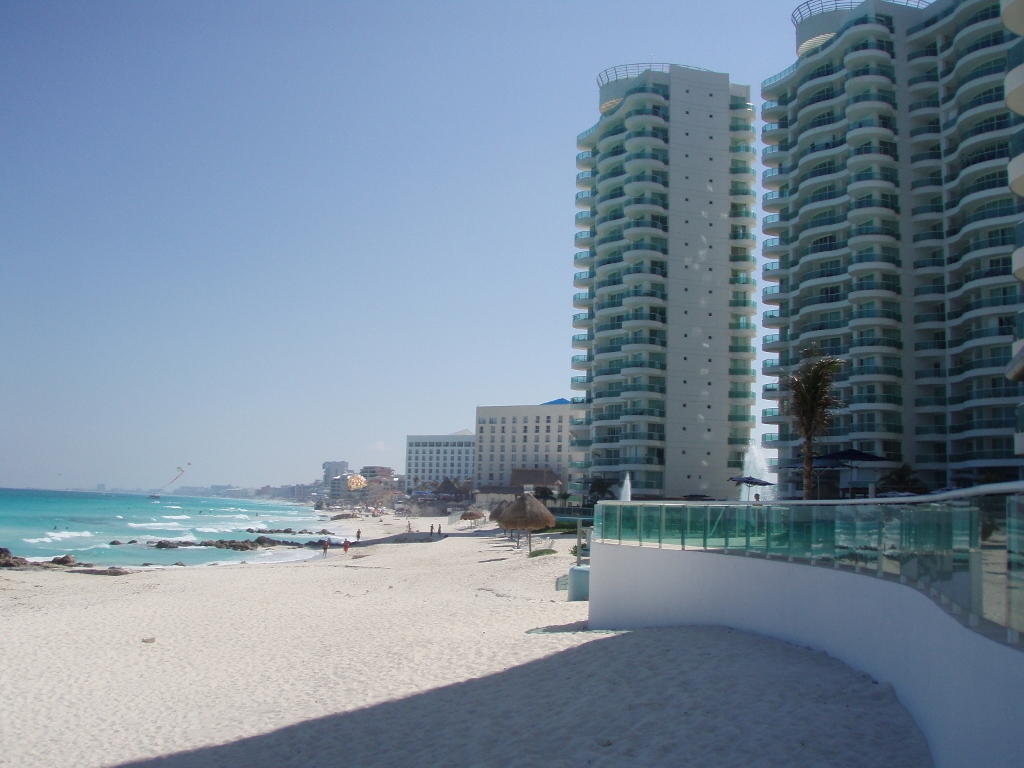 Rooms with a view in Cancun
Rooms with a view in Cancun
I have already mentioned in the first sequel of my travel stories that the island on which the hotel zone here is located has the shape of number 7. Until now I walked along the longer side of the “number” and then I got to the point where the two lines of the number join, which in the case of Cancun is the Cancun Point (Punta Cancún).
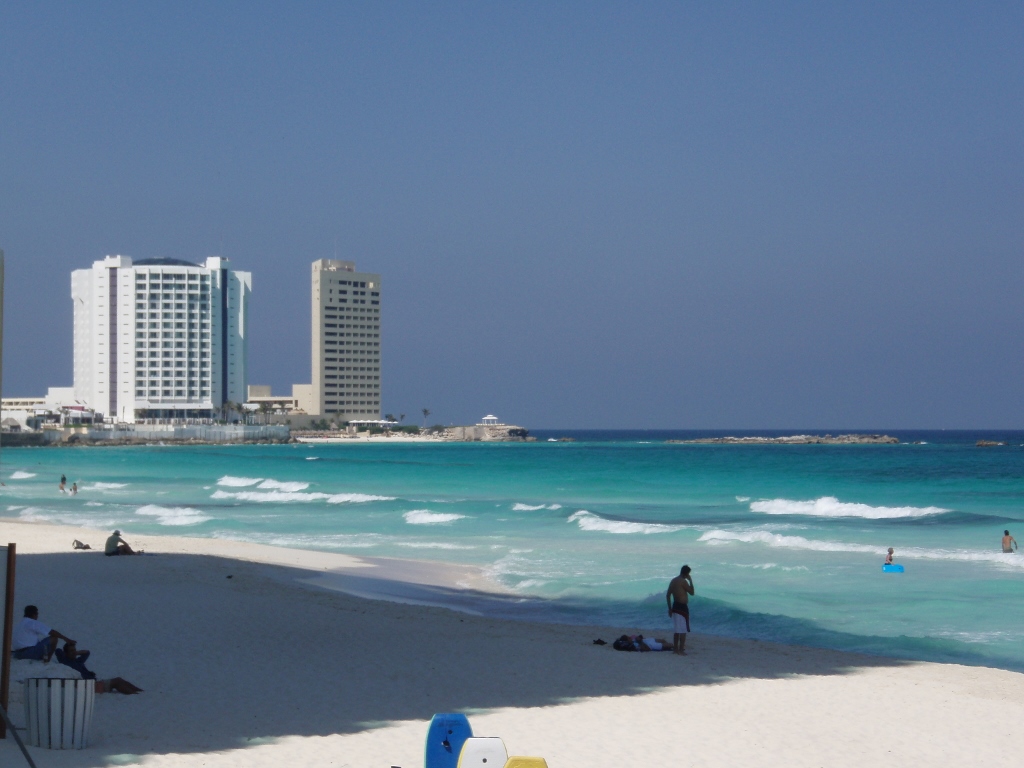 View towards the Punta Cancún
View towards the Punta Cancún
Meanwhile, I became thirsty. Here, by the beach, there are certainly places where one can sit and have a coffee or a juice, but, I was taking my budget limits seriously, so I had to look for alternative ways to get refreshed and to relax.
To start with, I finally came across a spacious passage that served as a link between the beach and the main street and there was also a large shopping mall beside the passage. While I was looking for a place inside to sit down and have something to drink, Fortuna came my way, so I accidently came across a balcony on the upper floor of the mall which was not a terrace of a restaurant or a café, but simply an ordinary balcony within the shopping mall from which there was a fine view at the beach and the Caribbean Sea. However, what actually constituted the exceptionally fortunate circumstances was the fact that somebody had already taken out a few chairs there placing them against the wall. At the time I came out there to have a look at the beach, the chairs were empty. Since I had already bought a coffee along the way, I took up the opportunity, sat down on one of the chairs, put my feet up on the fence and enjoyed. The view was magnificent, I was in the shade, it was warm, but there was a pleasant breeze. All in all, it would not have been any better in any of the official cafés.
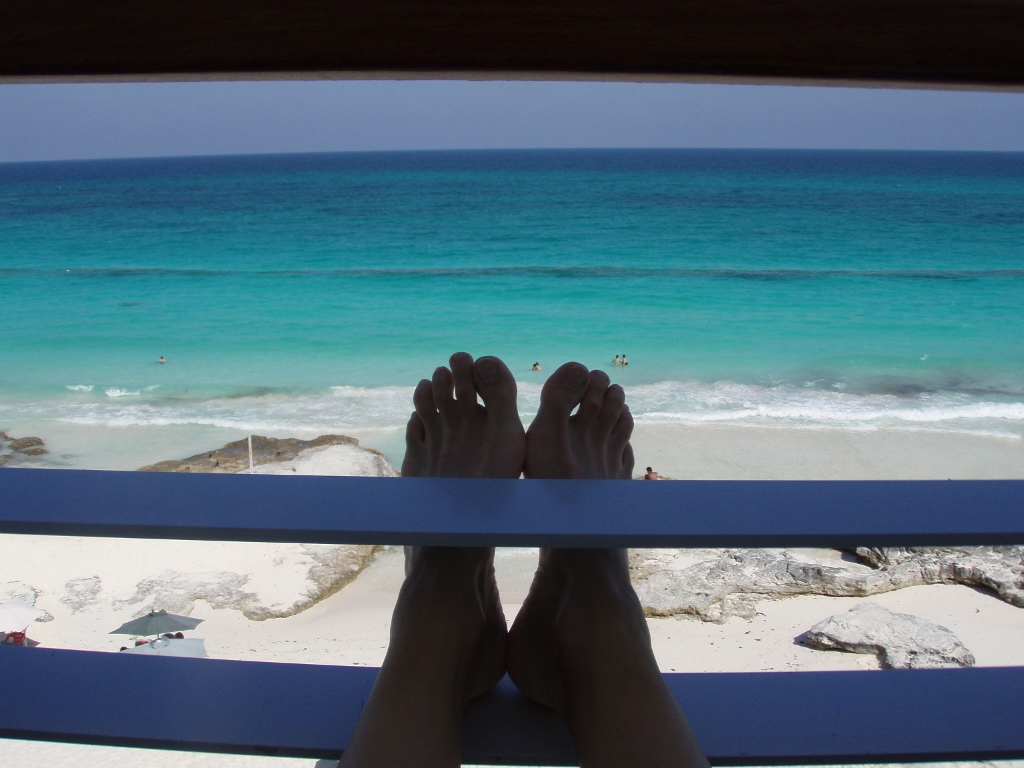 A break for an informal coffee
A break for an informal coffee
Since there is this spacious passage from the main street here, then there were also more daily visitors and consequently there were some people in the water. It was already afternoon, so perhaps the conditions were deemed safe.
For a while I also watched a couple of pelicans that were catching fish not far from where I was sitting by diving into the water like an arrow, but they flew away after some time and I also moved on and continued with my sightseeing of the hotel zone in Cancun.
So I moved to the top of “number 7.” There are also numerous hotels and beaches there, too.
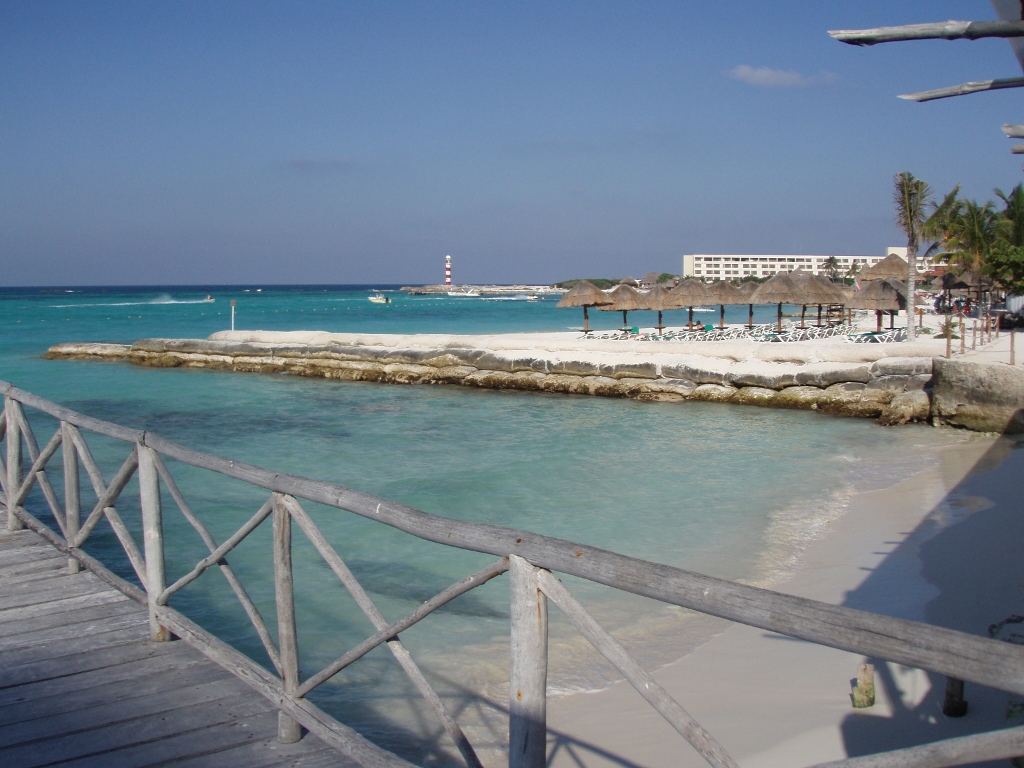 North section of the hotel zone in Cancun
North section of the hotel zone in Cancun
At some point I returned to the centre of the city where my hotel was and then I went to my room in order to eat some of the fruits I had bought earlier that morning at a supermarket.
While I was in the room, I realised I had made a huge mistake. Namely, that morning I did buy a suntan spray and applied it to my legs and arms. And those were perfect. But, I had forgotten my neck! Luckily, I had plaited my hair and so the back of my neck was not too bad. But the front and the sides... Admittedly, I did have with me an excellent skin cream, so the skin of my neck did not hurt, but I realised I had to protect my neck physically over the next few days, since this cream would not feel good in excessive heat. And so I went shopping while the shops were still open. I urgently needed – a shawl! Needless to say, this is not a popular item of clothes in a tropical destination, so I had difficulties finding it, but I did find it eventually. So, I could relax which meant I would go for dinner.
This was not a problem at all in the centre of the city, since there are numerous restaurants and bars. Almost one next to the other.
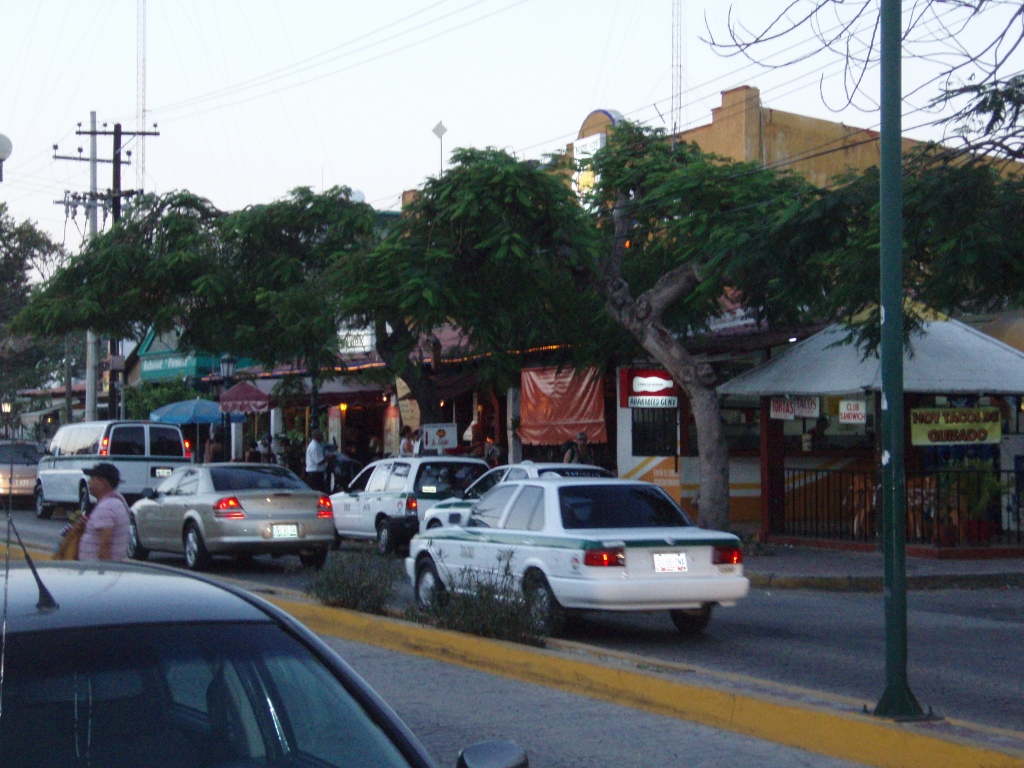 Dusk in the centre of Cancun
Dusk in the centre of Cancun
Although I opted for a very touristy restaurant, I liked the dinner. I ordered tacos, small tortillas filled with different things, along which I also got guacamole, the fabulous avocado sauce, as well as a sauce made of black beans. In order not to wait idly, I also ordered nachos as a starter with two dipping sauces. And, of course, I took a beer. A perfect combination!
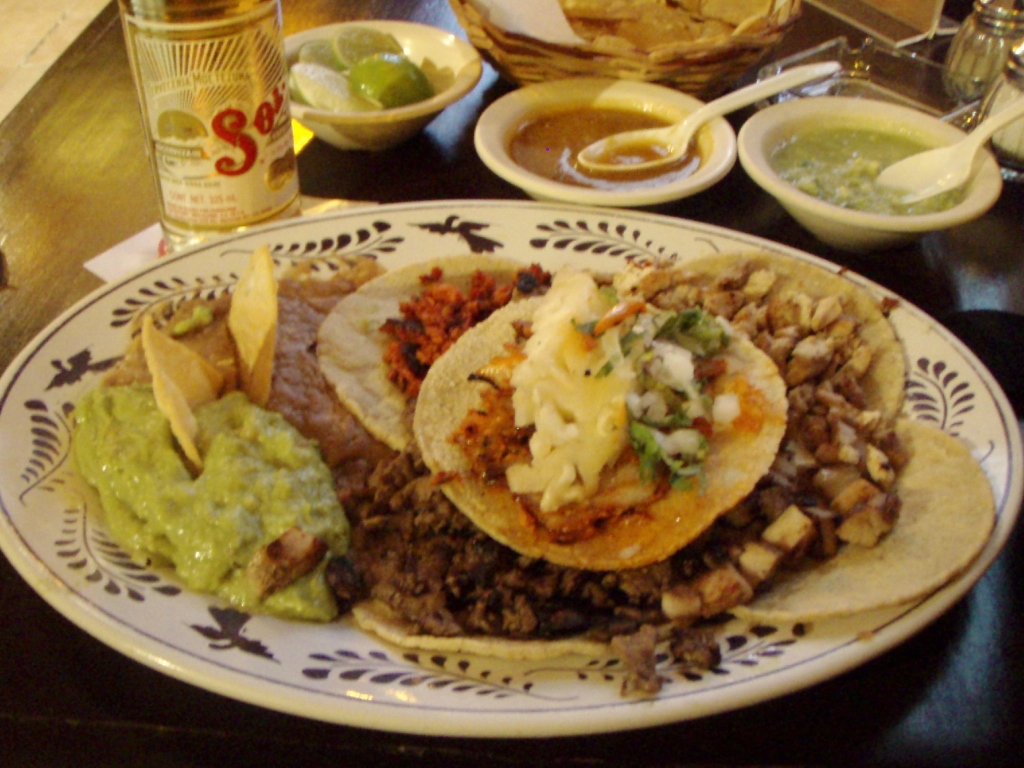 Dinner in Cancun
Dinner in Cancun
With my stomach gloriously full, I returned to my hotel and soon I was asleep. The following day I was starting with my tour around south Mexico and Central America.
In the morning I woke up nicely, packed up the few things I had taken out of my large backpack and went to the coach terminal. While packing up I started to be aware of a very important lesson for my travels – never take make-up with you. For who knows which, now I think very stupid, reason I brought some make-up with me on this journey. I had put it all in a small toiletry bag and then I had placed that bag on the top of the interior of the backpack lest it should get squashed. I did put on some make up on the first day in Cancun and that could suggest that I needed the make-up. However, not ever again during this travel that lasted for almost a month did I make up, but I did had to bother with the toiletry bag every single time I opened and closed the backpack. I was fed up with it and never again did I take make-up to any private trip. Lesson learned.
My first destination when visiting this region was the archaeological site of Chichén Itzá, with a note that my plan was to continue after the sightseeing to the city of Merida in order to sleep there. My partial concern was what I would do with my large backpack while doing the sightseeing, but I was told that there were lockers at the coach terminal by the Chichén Itzá site where I would be able to leave it.
The coach left Cancun on time and that was good, but it was horrible how much the air-conditioning was turned up and I was freezing. Luckily, in my small backpack I had a long-sleeve shirt and a large scarf (for covering my legs), but this did not seem enough. Who knows how freezing I would feel without it. Since I had quite an unpleasant experience with these large temperature changes when I was in India where I even fell sick because of it, I decided to get a small blanket from the big backpack before continuing to Merida. It was precisely this experience from India that encouraged me to bring with me to the tropics a small blanket I had “adopted” on a plane. (This is not nice, but it is practical. On the other hand, I actually don’t know where I could buy such a small blanket that could fit into a small backpack.) In any case, this was also one of the lessons I have learned on my travels. (It seems to me that I’m quite talented for the learning of lessons.)
Be as it may, the road here runs across the north part of Yucatan and so from the coach I could watch the landscapes of this peninsula. I had read somewhere that we were supposed to be driving through a jungle, but I could often see dried and barren trees, i.e., the remains of former trees.
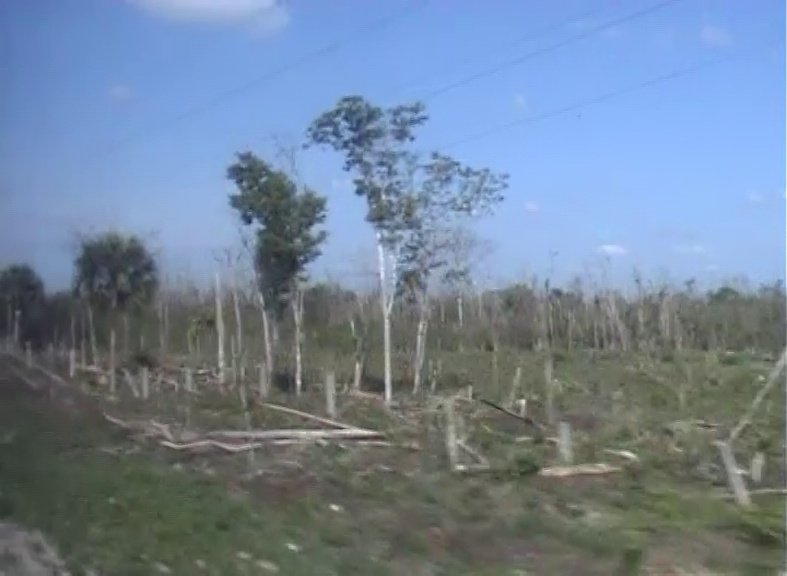 A bit blurry photo, but it is good as an illustration
A bit blurry photo, but it is good as an illustration
It is almost certain that the reason for this lied in the fact that two and a half years before my arrival here, in October 2005, a hurricane passed over the Yucatan peninsula (among other places). Because of the quantity of rain that fell in the area of northeast Yucatan at the time (1.6 metres within 24 hours), this was the biggest accumulation ever recorded in the Western hemisphere.
However, in April 2008, the day was sunny and after some two and a half hours of drive the coach arrived in the terminal near the site of Chichén Itzá.
To start with, I left my big backpack in one of the numerous bigger or smaller lockers that exist there and that service was even free of charge. This meant that I could easily and unburdened walk around the site, but this solving of the issue of the backpack mostly meant that I saved a day in this way, i.e., I could visit Chichén Itzá “on my way,” rather than come here on a daily excursion. I also bought a ticket for the continuation of my journey for later in the afternoon when the site gets closed. Since I did all of this, I bought a ticket and entered the area of the site.
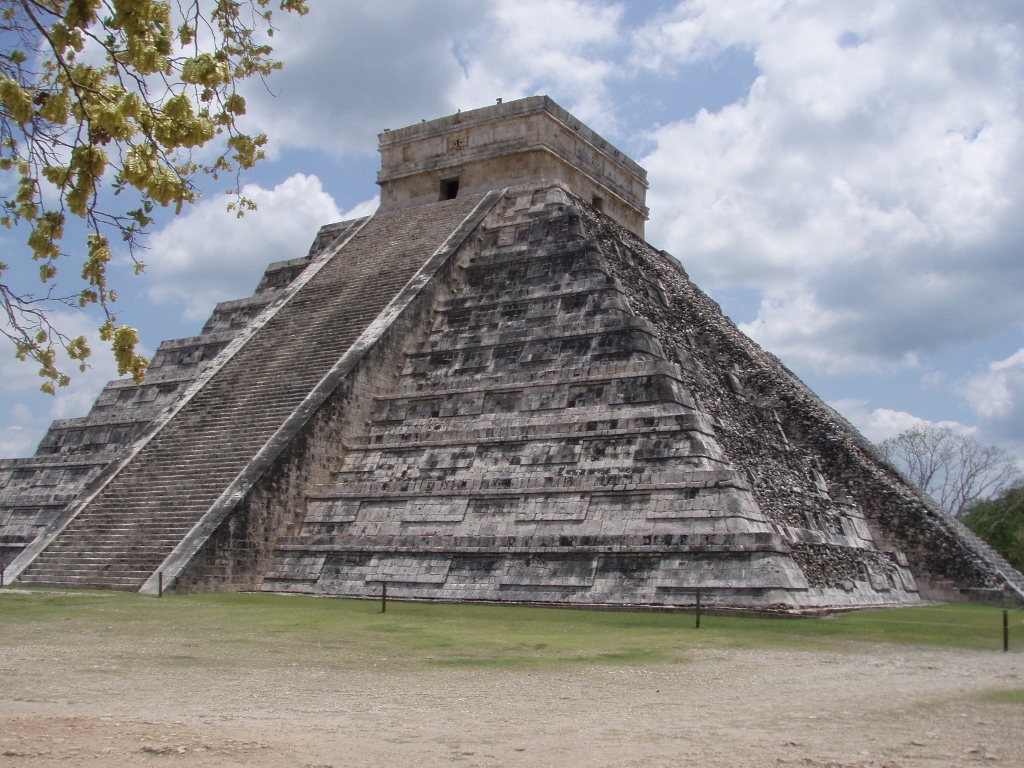 Chichén Itzá, El Castillo
Chichén Itzá, El Castillo
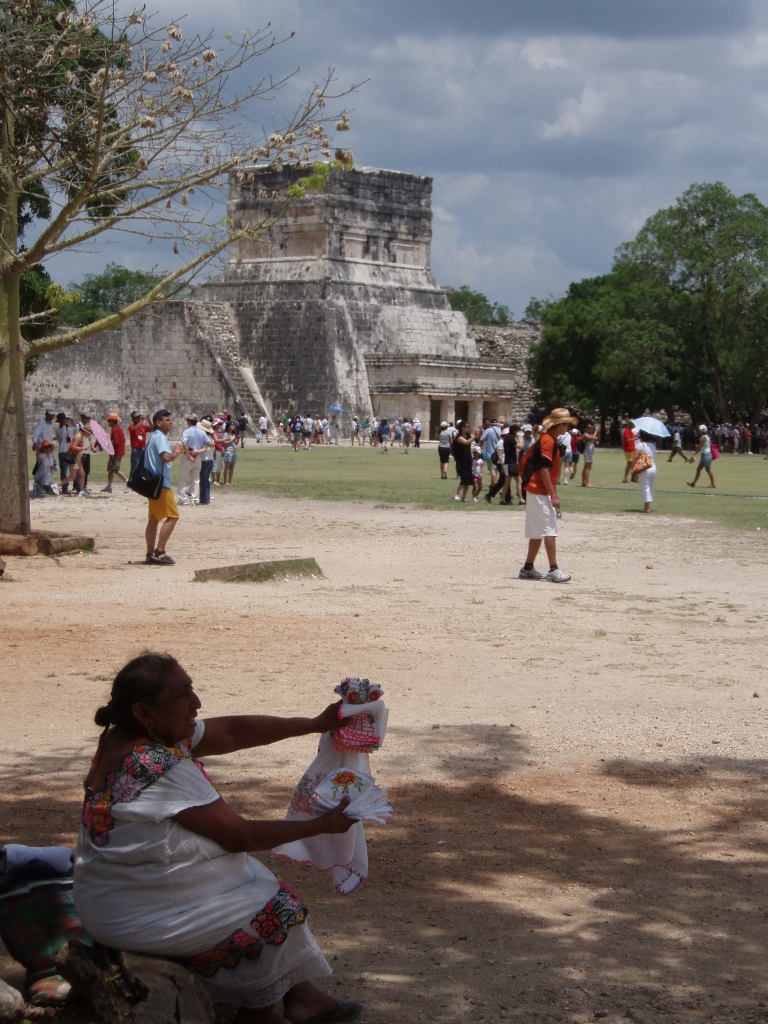 Chichén Itzá
Chichén Itzá
Chichén Itzá is an archaeological site that belongs to the civilisation of the ancient Maya people. Throughout the history, the Mayas have inhabited the areas covering present-day Guatemala and Belize, parts of El Salvador and Honduras, as well as eastern parts of present-day Mexico and all of Yucatan. Without any afore-conceived intention, as it would turn out, with this journey I actually covered precisely the territories inhabited by the ancient Mayas.
As for the timeframe, the historians differentiate several periods within the Maya civilisation, but the most important ones are the Preclassic (2000 BCE – 250 CE), the Classic (250 CE – 950 CE) and the Postclassic periods (950 CE until around 1500 CE).
Chichén Itzá reached its zenith in the period from 600 CE to around 1200 CE. It was one of the biggest Mayan cities. Since the Maya civilisation was not politically unified, in terms of a single ruler, each city was more or less a state, that is, a kingdom in its own right and so was Chichén Itzá which at its summit was the most important centre in the region of the northern Maya lowlands.
When one enters the site, first there is a large clearing in the centre of which there is an impressive pyramid called El Castillo, which means “the castle,” but this structure never had any residential function. Still, I will deal with it a little later since I started my visit from a group of structures that extend south from El Castillo.
The first bigger and more important structure one comes across is El Osario, which means “the ossuary.” This is a four-sided pyramid which has a stairway on each of the sides. On the top, there are remains of a temple.
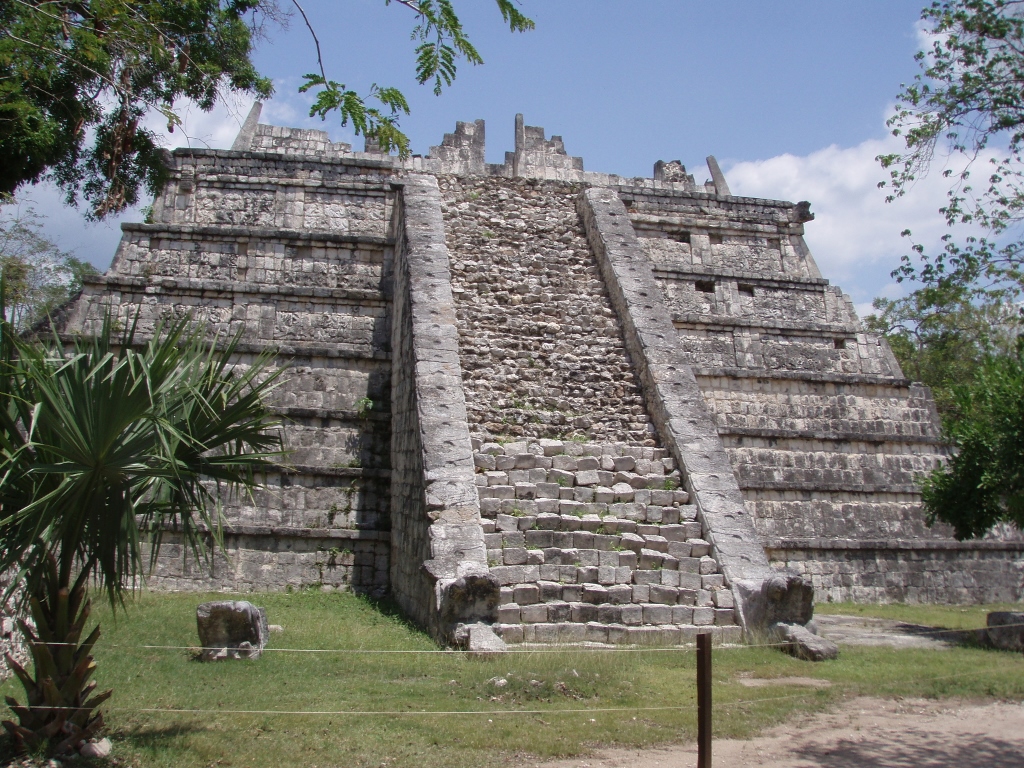 El Osario
El Osario
By the way, the names for different structures I saw not only in Chichén Itzá, but also during the entire journey, were given by the Spanish when they discovered the old buildings or by different researchers of the later times. Thus, El Osario used to be called the Tomb of the High Priest, since several skeletons have been found in a natural cave that exists under the pyramid. However, over time, the archaeologists have established that this was neither a tomb nor were any priests buried here. Still, because of the bones that have been found there, the structure has been given the new and more appropriate name.
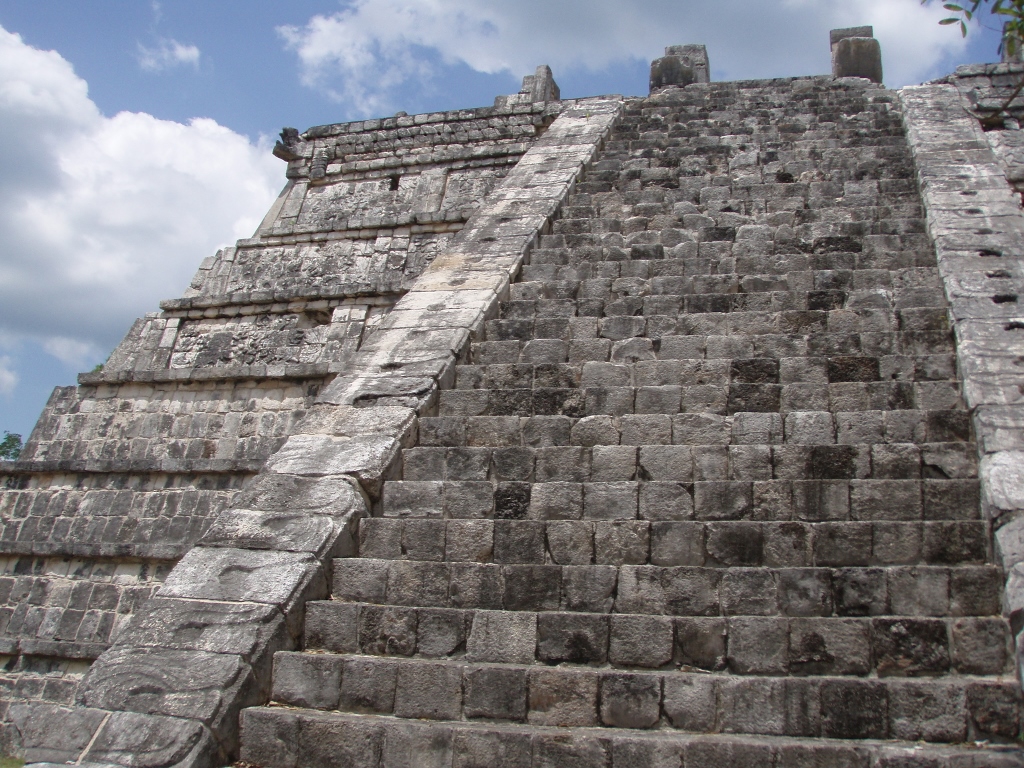 El Osario, a stairway
El Osario, a stairway
Already here at the balustrade of El Osario I could see a very nice stone decoration in the shape of a feathered serpent which the Mayas called Kukulkan and it was one of their main deities. The feathered serpent, as a deity, was very popular throughout Central America and its counterpart among the Aztecs and the Toltecs was Quetzalcoatl. It is not known exactly who influenced whom, but within the scope of all of these civilisations the feathered serpent was very important and it was frequently depicted in the temples many of which were dedicated precisely to it.
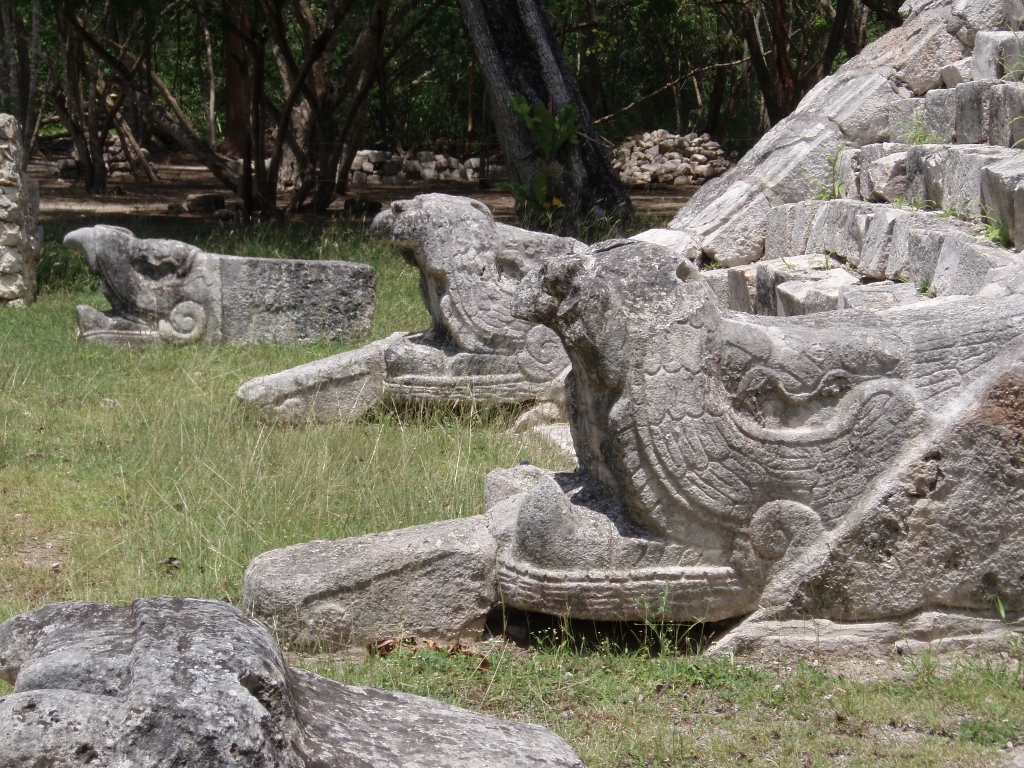 El Osario, the bottom of the stairway
El Osario, the bottom of the stairway
In addition, I would also like to mention that the sides of these pyramids were often made at a very big angle and thus the stairways were very steep.
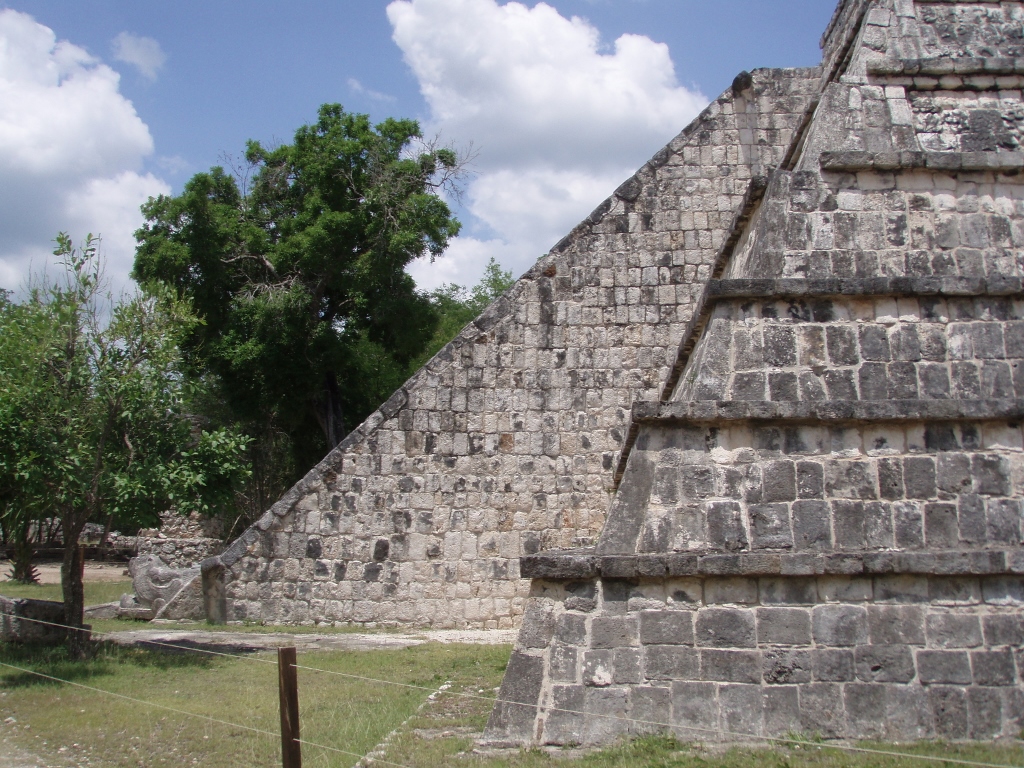 El Osario, the side view at the stairway
El Osario, the side view at the stairway
While I was walking slowly around El Osario pyramid, taking photos of different details, I was actually standing very close to a group of tourists who were there with their guide. This must have been a group of Italians and in any case while accidently hearing their guide I found out about some details. As I’ve mentioned before, I did not have a proper guidebook about Mexico, but only some basic data, so I appreciated all additional information. Thus I learned of god Chaac, yet another very important deity that was often shown on the structures built by the ancient Mayas. This was the god of rain, thunder and storms. He was of key importance for the Mayas since his activities ensured the rainfall and consequently the growth of the crops, primarily the maize.
Beside El Osario there is a pillar (the group’s guide said there used to be four of them – one in each corner) where it is possible to see several of the typical depictions or masks of god Chaac.
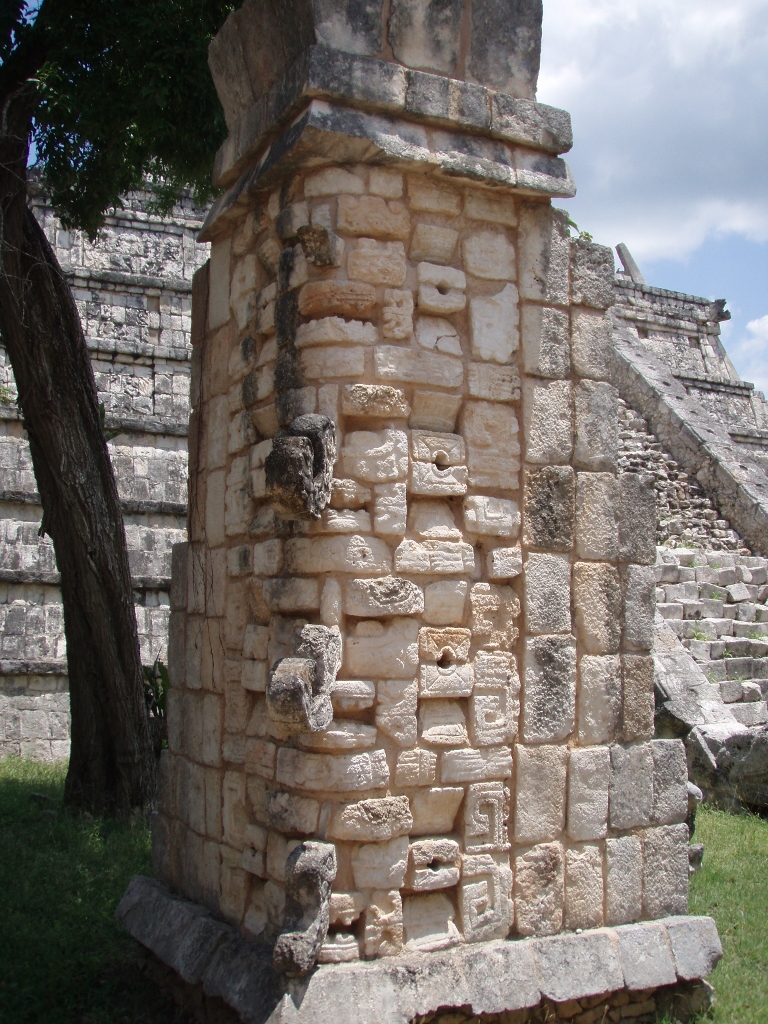 Pillar with four masks of god Chaac
Pillar with four masks of god Chaac
If it is not clear how god Chaac was traditionally depicted, here is one of his masks from up close: there are visible eyes, mouth with teeth and square ear-rings with holes, while the most pronounced is his nose in the shape of a small trunk.
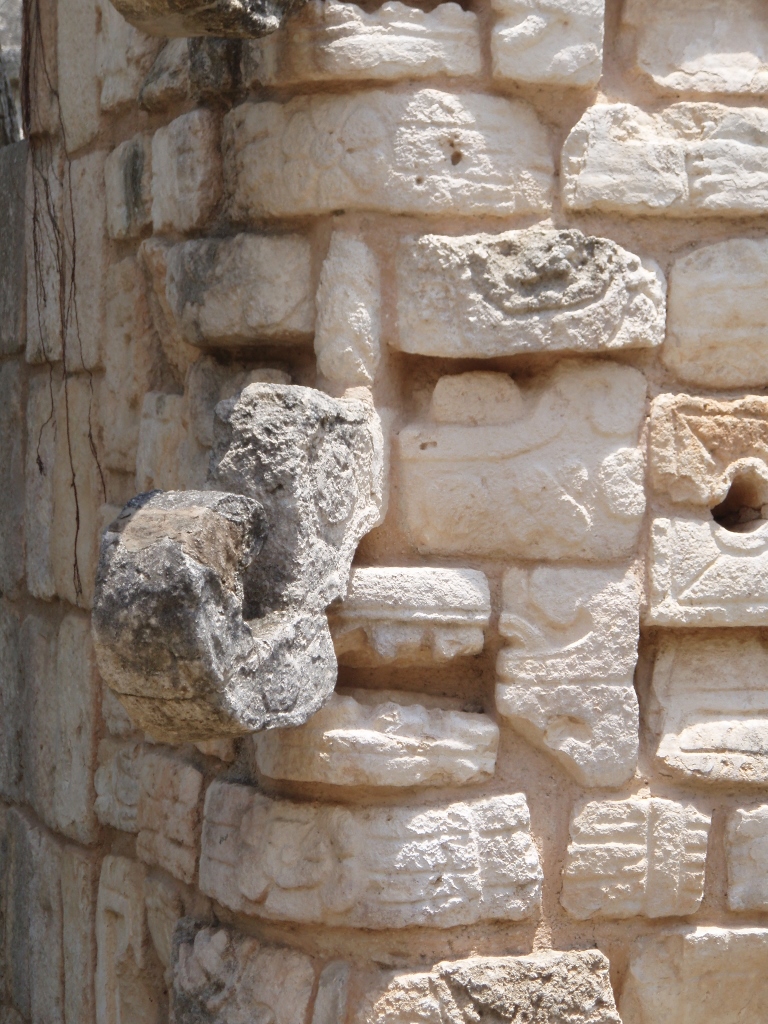 God Chaac
God Chaac
Then I came across something which back in 2008 was not marked in the maps as very important and there were not many people there, but I found it interesting to see how the Mayas used to make the corners of the supporting walls – larger pieces of stones laid down on the corners. Later I realised this was the Casa Colorada, meaning the Red House, one of the best preserved in Chichén Itzá. It was right behind its back wall from where I made the following photo that there is a small ballcourt.
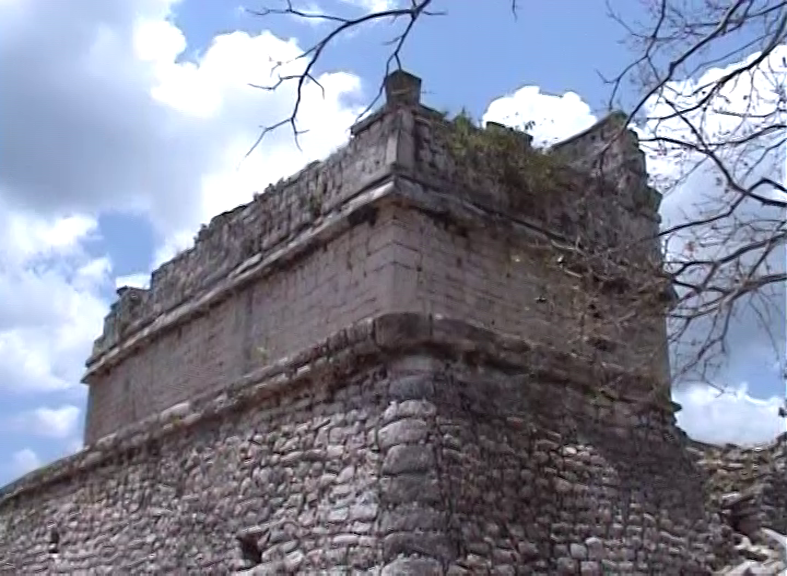 Casa Colorada, as seen from the back
Casa Colorada, as seen from the back
Generally speaking, at the site which covers the surface area of around 5 square kilometres there is a myriad of structures that are in a better or a poorer state, that are bigger or smaller, but during my visit I focused mostly on those that are considered the most important. This is, for instance, the case with the next structure I came across. It is a temple-observatory called El Caracol, meaning “the snail.”
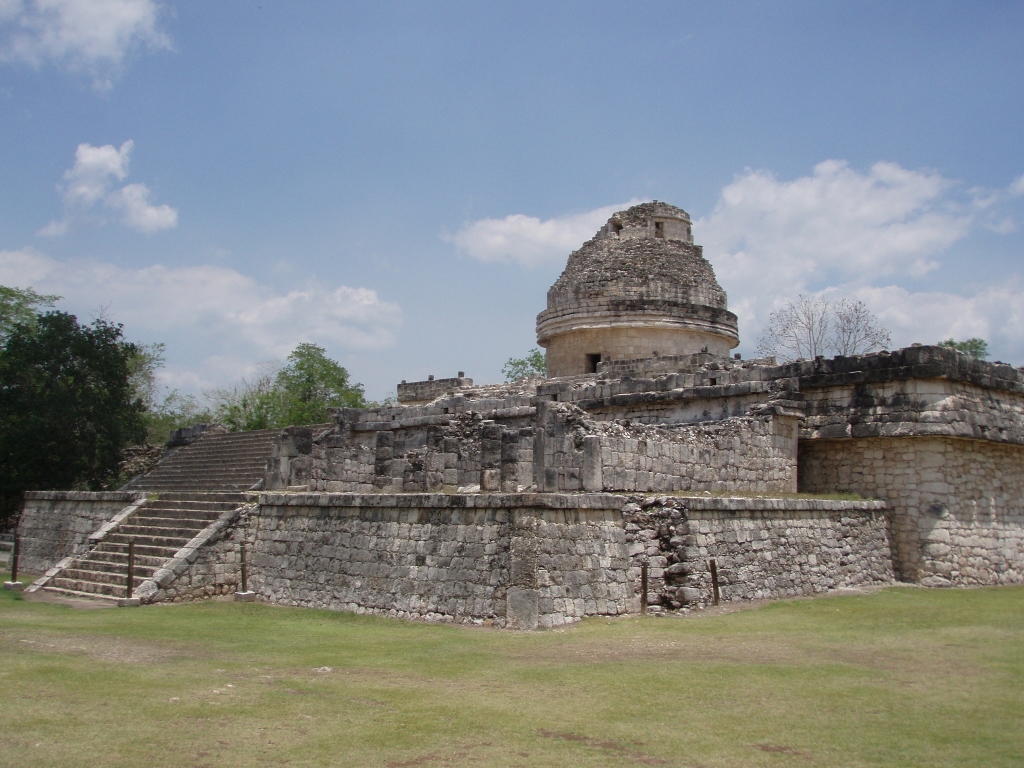 El Caracol
El Caracol